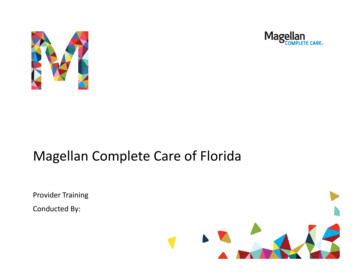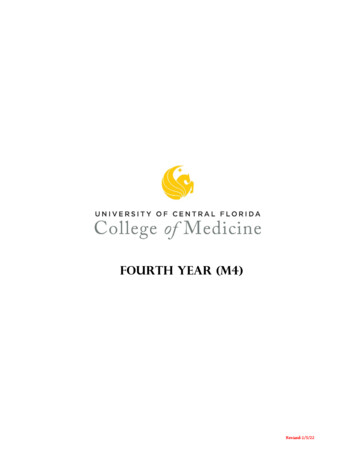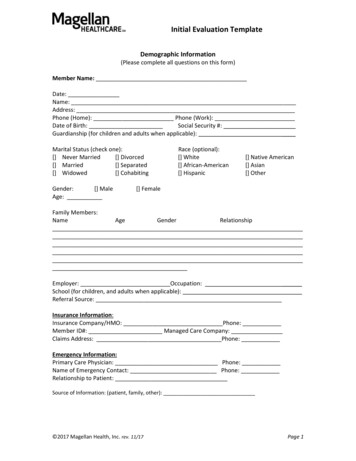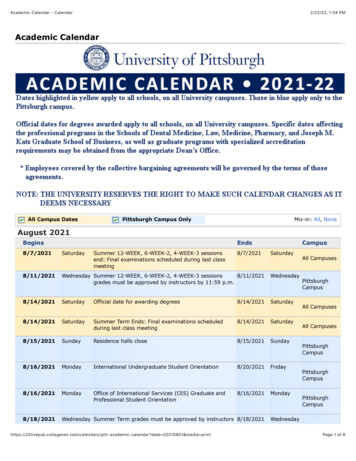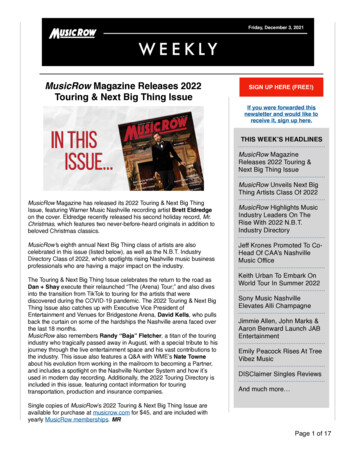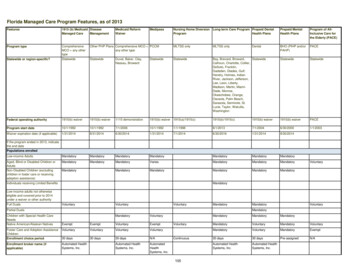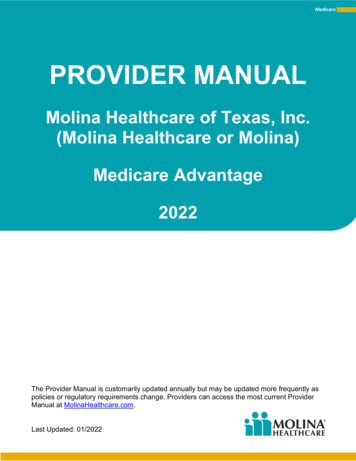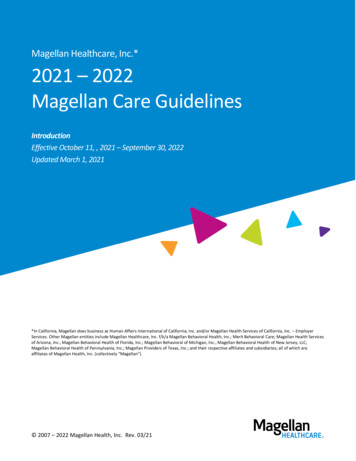
Transcription
Magellan Healthcare, Inc.*2021 – 2022Magellan Care GuidelinesIntroductionEffective October 11, , 2021 – September 30, 2022Updated March 1, 2021*In California, Magellan does business as Human Affairs International of California, Inc. and/or Magellan Health Services of California, Inc. – EmployerServices. Other Magellan entities include Magellan Healthcare, Inc. f/k/a Magellan Behavioral Health, Inc.; Merit Behavioral Care; Magellan Health Servicesof Arizona, Inc.; Magellan Behavioral Health of Florida, Inc.; Magellan Behavioral of Michigan, Inc.; Magellan Behavioral Health of New Jersey, LLC;Magellan Behavioral Health of Pennsylvania, Inc.; Magellan Providers of Texas, Inc.; and their respective affiliates and subsidiaries; all of which areaffiliates of Magellan Health, Inc. (collectively “Magellan”). 2007 – 2022 Magellan Health, Inc. Rev. 03/21
Table of ContentsPreamble - Principles of Medical Necessity Determinations . 3Medical Necessity Definition. 5Levels of Care & Service Definitions . 6Magellan Care Guidelines . 10Term Definitions . 122021 – 2022 Magellan Care Guidelines2
Preamble - Principles of MedicalNecessity DeterminationsMagellan uses MCG Guidelines , along with its proprietary clinical criteria, Magellan HealthcareGuidelines, as the primary decision support tools for our Utilization Management Program.Collectively, they are known as the Magellan Care Guidelines.Magellan uses The ASAM Criteria and other state-developed guidelines for management ofsubstance use services when required by state regulations or an account. In addition, otherguidelines including the Level of Care Utilization System (LOCUS), Children’s Level of CareUtilization System (CALOCUS), and Early Childhood Service Intensity Instrument (ECSII) are usedwhen required by state regulations or an account. All guidelines meet federal, state, industryaccreditation, and account contract requirements. They are based on sound scientific evidencefor recognized settings of behavioral health services and are designed to decide the medicalnecessity and clinical appropriateness of services.Individualized, Needs-Based, Least-Restrictive TreatmentMagellan is committed to the philosophy of providing treatment at the most appropriate, leastrestrictive level of care necessary to provide safe and effective treatment and meet theindividual patient’s biopsychosocial needs. We see the continuum of care as a fluid treatmentpathway, where patients may enter treatment at any level and be moved to more or lessintensive settings or levels of care as their changing clinical needs dictate. At any level of care,such treatment is individualized, active and takes into consideration the patient’s stage ofreadiness to change/readiness to participate in treatment.The level of care criteria that follow are guidelines for determining medical necessity for theDiagnostic and Statistical Manual of Mental Disorders Fifth Edition (DSM-5 ) disorders.Individuals may at times seek admission to clinical services for reasons other than medicalnecessity, e.g., to comply with a court order, to obtain shelter, to deter antisocial behavior, todeter runaway/truant behavior, to achieve family respite, etc. However, these factors do notalone determine a medical necessity decision. Further, coverage for services is subject to thelimitations and conditions of the member benefit plan. Specific information in the member’scontract and the benefit design for the plan dictate which medical necessity criteria areapplicable.Although the Magellan Care Guidelines are divided into “psychiatric” and “substance-related”sets to address the patient’s primary problem requiring each level of care, psychiatric andsubstance-related disorders are often co-morbid. Thus, it is very important for all treatmentfacilities and providers to be able to assess these co-morbidities and address them along withthe primary problem.2021 – 2022 Magellan Care Guidelines3
Clinical Judgment and ExceptionsThe Magellan Care Guidelines direct both providers and reviewers to the most appropriate levelof care for a patient. While these criteria will assign the safest, most effective and leastrestrictive level of care in nearly all instances, an infrequent number of cases may fall beyondtheir definition and scope. Thorough and careful review of each case, including consultationwith supervising clinicians, will identify these exceptions. As in the review of non-exceptionalcases, clinical judgment consistent with the standards of good medical practice will be used toresolve these exceptional cases.All medical necessity decisions about proposed admission and/or treatment, other thanoutpatient, are made by the reviewer after receiving a sufficient description of the currentclinical features of the patient’s condition that have been gathered from a face-to-faceevaluation of the patient by a qualified clinician. Medical necessity decisions about each patientare based on the clinical features of the individual patient relative to the patient’s socio-culturalenvironment, the medical necessity criteria, and the real resources available. We recognize thata full array of services is not available everywhere. When a medically necessary level does notexist (e.g., rural locations), we will support the patient through extra-contractual benefits, orwe will authorize a higher than otherwise necessary level of care to ensure that services areavailable that will meet the patient’s essential needs for safe and effective treatment.2021 – 2022 Magellan Care Guidelines4
Medical Necessity DefinitionMagellan reviews mental health and substance abuse treatment for medical necessity.Magellan defines medical necessity as: “Services by a provider to identify or treat an illness thathas been diagnosed or suspected. The services are:1. consistent with:a. the diagnosis and treatment of a condition; andb. the standards of good medical practice;2. required for other than convenience; and3. the most appropriate supply or level of service.When applied to inpatient care, the term means: the needed care can only be safely given on aninpatient basis.” Each criteria set within each level of care category is a more detailed elaboration of the abovedefinition for the purposes of establishing medical necessity for these health care services.Particular rules in each criteria set apply in guiding a provider or reviewer to a medicallynecessary level of care (please note the possibility and consideration of exceptional patientsituations described in the preamble when these rules may not apply). The criteria set ischaracterized by admission, or initiation of treatment, and continued care criteria. Theadmission and continued care of a patient at a particular level of care requires the criteria to bemet, as indicated (Note: this often requires that the admission criteria are still fulfilled). Specificrules for the admission and continued care groupings are noted within the criteria sets.Magellan Care Guidelines do not supersede state or federal law or regulation, includingMedicare National or Local Coverage Determinations, concerning scope of practice for licensed,independent practitioners, e.g., advanced practice nurses. Magellan utilizes its customers’ definition of “medical necessity” as required.2021 – 2022 Magellan Care Guidelines5
Levels of Care & Service DefinitionsMagellan believes that optimal, high-quality care is best delivered when patients receive carethat meets their needs in the least-intensive, least-restrictive setting possible. Magellan’sphilosophy is to endorse care that is safe and effective, and that maximizes the patient’sindependence in daily activity and functioning.Magellan has defined levels of care as detailed below. These levels of care may be furtherqualified by the distinct needs of certain populations who frequently require behavioral healthservices. Children, adolescents, geriatric adults and those with substance use and eatingdisorders often have special concerns not present in adults with mental health disorders alone.In particular, special issues related to family/support system involvement, physical symptoms,medical conditions and social supports may apply. More specific criteria sets in certain of thelevel of care definitions address these population issues. These levels of care are specific to theaccount or health plan benefit design and may not all apply to all Magellan accounts. Thelevels of care definitions are:1. Hospitalizationa. Hospitalization describes the highest level of skilled psychiatric and substance abuseservices provided in a facility. This could be a freestanding psychiatric hospital, apsychiatric unit of general hospital or a detoxification unit in a hospital. Settings that areeligible for this level of care are licensed at the hospital level and provide 24-hourmedical and nursing care.b. This definition also includes crisis beds, hospital-level rehabilitation beds for substanceuse disorders and 23-hour beds that provide a similar, if not greater, intensity of medicaland nursing care. For crisis and 23-hour programs, the Inpatient Behavioral Health Levelof Care guidelines apply for medical necessity reviews. For hospital-level substanceabuse rehabilitation, the Substance-Related Disorders, Inpatient Behavioral Health Levelof Care guidelines apply.2. 23-Hour Observationa. The main objective of 23-hour observation is to promptly evaluate and stabilizeindividuals presenting in a crisis situation. This level of care provides up to 23 hours and59 minutes of observation and crisis stabilization, as needed. Care occurs in a secure andprotected environment staffed with appropriate medical and clinical personnel,including psychiatric supervision and 24-hour nursing coverage.b. Aspects of care include a comprehensive assessment and the development and deliveryof a treatment plan. The treatment plan should emphasize crisis intervention servicesintended to stabilize and restore the individual to a level of functioning that does notnecessitate hospitalization. In addition, 23-hour observation may be used to completean evaluation to determine diagnostic clarification to establish the appropriate level of2021 – 2022 Magellan Care Guidelines6
care. As soon as the risk level is determined, diagnostic clarity is established, and/orcrisis stabilization has been achieved, appropriate referral and linkage to follow-upservices will occur.c. If clinical history or initial presentation suggested that the individual required a secure andprotected inpatient level of care for more than 23 hours and 59 minutes, this level of care wouldnot be appropriate.3. Residential TreatmentResidential Treatment is defined as a 24-hour level of care that provides persons with longterm or severe mental disorders and persons with substance-related disorders withresidential care. This care is medically monitored, with 24-hour medical and nursing servicesavailability. Residential care typically provides less intensive medical monitoring thansubacute hospitalization care. Residential care includes treatment with a range of diagnosticand therapeutic behavioral health services that cannot be provided through existingcommunity programs. Residential care also includes training in the basic skills of living asdetermined necessary for each patient. Residential treatment for psychiatric conditions andresidential rehabilitation treatment for alcohol and substance abuse are included in thislevel of care. Settings that are eligible for this level of care are licensed at the residentialintermediate level or as an intermediate care facility (ICF). Licensure requirements for thislevel of care may vary by state.4. Partial HospitalizationThese programs are defined as structured and medically supervised day, evening and/ornight treatment programs. The services include medical and nursing, but at less intensitythan that provided in a hospital setting. The patient is not considered a resident at theprogram. The range of services offered is designed to address a mental health and/orsubstance-related disorder through an individualized treatment plan provided by acoordinated multidisciplinary treatment team.5. Intensive Outpatient ProgramsIntensive outpatient programs are defined as having the capacity for planned, structured,service provision over the course of multiple weeks, and may include service provision overweekends. These encounters are usually comprised of coordinated and integratedmultidisciplinary services. The range of services offered are designed to address a mental ora substance-related disorder and could include group, individual, family or multi-familygroup psychotherapy, psychoeducational services, and adjunctive services such as medicalmonitoring. These services would include multiple or extendedtreatment/rehabilitation/counseling visits or professional supervision and support. Programmodels include structured “crisis intervention programs,” “psychiatric or psychosocialrehabilitation,” and some “day treatment.” (Although treatment for substance-relateddisorders typically includes involvement in a self-help program, such as Alcoholics2021 – 2022 Magellan Care Guidelines7
Anonymous or Narcotics Anonymous, program time as described here excludes times spentin these self-help programs, which are offered by community volunteers without charge).6. Outpatient TreatmentOutpatient treatment is typically individual, family and/or group psychotherapy, andconsultative services (including nursing home consultation). Times for provision of theseservice episodes range from fifteen minutes (e.g., medication checks) to fifty minutes (e.g.,individual, conjoint, family psychotherapy), and may last up to two hours (e.g., grouppsychotherapy).7. AmbulatoryAmbulatory services are outpatient treatment services, provided by qualified mental healthprofessionals and directed toward reversing symptoms of acute mental health disorders,and/or substance use disorders in order to facilitate improvement, maintain stability andincrease functional autonomy for persons with various forms of mental health andsubstance use disorders. Outpatient services are specific in targeting the symptoms orproblem being treated. Examples of types of Counseling and Psychotherapy include thefollowing: individual psychotherapy behavioral therapy medication management shared medical appointments psychiatric, psychological, and psychosocial assessment group psychotherapy conjoint/marital therapy family therapy outpatient detox services outpatient buprenorphine maintenance servicesCommon settings or sites for these services include providers’ offices and clinics.8. Day TreatmentDay treatment consists of a community-based mix of psychosocial treatment (includingindividual, family, and group-based psychotherapy), educational, and recreational activitiesfor patients with behavioral health conditions associated with functional impairment (e.g.,inability to maintain full-time engagement in work, school, or home environment asappropriate). Day treatment is designed to address issues that are chronic in nature, ratherthan acute exacerbations or urgent clinical issues; services tend to overlap with regularschool or work schedules, and typically are of longer duration than intensive outpatient orpartial hospital programs (e.g., an adolescent in day treatment may be enrolled in aprogram which lasts for the entire school year. While patients for whom day treatment isindicated do not require the intensity of services available in an intensive outpatient or2021 – 2022 Magellan Care Guidelines8
partial hospital program, some day treatment programs provide diagnostic, medical,psychiatric, or other adjunctive treatment modalities, either directly or througharrangements made by the program. These services may be provided over an extendedperiod of time.2021 – 2022 Magellan Care Guidelines9
Magellan Care GuidelinesMCG Guidelines Below is a list of the MCG Guidelines Magellan will use for 2021 – 2022 (varies by account). Toview a copy of the MCG Guidelines , please contact Magellan Healthcare.MCG Guidelines for 2021-2022Inpatient Behavioral Health Level of Care, AdultInpatient Behavioral Health Level of Care, Child or AdolescentOutpatient Behavioral Health Level of Care, AdultOutpatient Behavioral Health Level of Care, Child or AdolescentResidential Behavioral Health Level of Care, AdultResidential Behavioral Health Level of Care, Child or AdolescentPartial Hospital Behavioral Health Level of Care, AdultPartial Hospital Behavioral Health Level of Care, Child or AdolescentIntensive Outpatient Program Behavioral Health Level of Care, AdultIntensive Outpatient Program Behavioral Health Level of Care, Child or AdolescentEating Disorders, Inpatient Behavioral Health Level of Care, AdultEating Disorders, Inpatient Behavioral Health Level of Care, Child or AdolescentEating Disorders, Residential Behavioral Health Level of Care, AdultEating Disorders, Residential Behavioral Health Level of Care, Child or AdolescentEating Disorders, Partial Hospital Behavioral Health Level of Care, AdultEating Disorders, Partial Hospital Behavioral Health Level of Care, Child or AdolescentEating Disorders, Intensive Outpatient Program Behavioral Health Level of Care, AdultEating Disorders, Intensive Outpatient Program Behavioral Health Level of Care, Child or AdolescentSubstance-Related Disorders, Inpatient Behavioral Health Level of Care, AdultSubstance-Related Disorders, Inpatient Behavioral Health Level of Care, Child or AdolescentSubstance-Related Disorders, Residential Behavioral Health Level of Care, AdultSubstance-Related Disorders, Residential Behavioral Health Level of Care, Child or AdolescentSubstance-Related Disorders, Partial Hospital Behavioral Health Level of Care, AdultSubstance-Related Disorders, Partial Hospital Behavioral Health Level of Care, Child or AdolescentSubstance-Related Disorders, Intensive Outpatient Program Behavioral Health Level of Care, AdultSubstance-Related Disorders, Intensive Outpatient Program Behavioral Health Level of Care, Child or AdolescentSubstance-Related Disorders, Outpatient Behavioral Health Level of Care, AdultSubstance-Related Disorders, Outpatient Behavioral Health Level of Care, Child or AdolescentMedication-Assisted Opioid WithdrawalDay Treatment Behavioral Health Level of CareObservation Behavioral Health Level of Care, AdultElectroconvulsive Therapy (ECT)2021 – 2022 Magellan Care Guidelines10
Magellan Healthcare GuidelinesBelow is a list of Magellan Healthcare Guidelines we will use for 2021-2022 (varies by account).To view a copy of the Magellan Healthcare Guidelines, see the following pages of thisdocument.Magellan Healthcare Guidelines for 2021 - 2022Transcranial Magnetic Stimulation TreatmentOutpatient Applied Behavior AnalysisPsychological TestingNeuropsychological Testing2021 – 2022 Magellan Care Guidelines11
Term Definitions1. Family:Individuals identified by an adult as part of his/her family or identified by a legal guardianon behalf of children. Examples would include parents/step-parents, children, siblings,extended family members, guardians, or other caregivers.2. Support System:A network of personal (natural) or professional contacts available to a person for practical,clinical, or moral support when needed. Examples of personal or natural contacts wouldinclude friends, church, school, work and neighbors. Professional contacts would includeprimary care physician, psychiatrist, psychotherapist, treatment programs (such asclubhouse, psychiatric rehabilitation), peer specialists, and community or state agencies.3. Significant Improvement:a. Services provided at any level of care must reasonably be expected to improve thepatient’s condition in a meaningful and measurable manner. The expectation is that thepatient can accomplish the following in the current treatment setting: continue to makemeasurable progress, as demonstrated by a further reduction in psychiatric symptoms,orb. Acquire requisite strengths in order to be discharged or move to a less restrictive levelof care.c. The treatment must, at a minimum, be designed to alleviate or manage the patient’spsychiatric symptoms so as to prevent relapse or a move to a more restrictive level ofcare, while improving or maintaining the patient’s level of functioning. “SignificantImprovement” in this context is measured by comparing the effect of continuingtreatment versus discontinuing it. Where there is a reasonable expectation that iftreatment services were withdrawn, the patient’s condition would deteriorate, relapsefurther, or require a move to a more restrictive level of care, this criterion would bemet.d. For most patients, the goal of therapy is restoration to the level of functioning exhibitedprior to the onset of the illness. For other psychiatric patients, particularly those withlong-term, chronic conditions control of symptoms and maintenance of a functionallevel to avoid further deterioration or hospitalization is an acceptable interpretation of“significant improvement”.2021 – 2022 Magellan Care Guidelines12
4. Qualified Healthcare Professional:An individual that is independently licensed and credentialed by and contracted, whoperforms a service within their scope of practice as permitted by applicable state and/orfederal law.5. Physician:Doctors of medicine (MD) and doctors of osteopathic medicine (DO) with an unrestrictedlicense to practice medicine.6. Geriatric:Generally, 65 years of age or older however treatment must not only address chronologicalage, but emotional and physical conditions.7. Adolescent:Experts generally agree that no one chronological age defines the end of adolescence.Rather, it is determined by considering a number of factors including chronological age,maturity, school and social status, family relationships, and living situation. For purposes ofconsistency, it is suggested that child and adolescent criteria sets be applied to individuals17 years of age or younger.8. Standardized Screening Tools:Tools used for cognitive assessment include, but are not limited to, the Mini-Mental StatusExamination (MMSE) and the Montreal Cognitive Assessment (MoCA).2021 – 2022 Magellan Care Guidelines13
2021-2022 Magellan Healthcare GuidelinesGuideline: Transcranial Magnetic Stimulation Treatment –CommercialEffective Date: October 11, 2021Last Review Date: February 15, 2021BackgroundTranscranial magnetic stimulation (TMS) may be considered for treatment of major depressivedisorder for adults who, by accepted medical standards, can be expected to improvesignificantly through medically necessary and appropriate TMS treatment.The treating psychiatrist must demonstrate that the patient’s symptoms are treatmentresistant to both a course of medication management and a course of psychotherapy.Resistance to treatment is defined in this guideline as a failure to achieve a fifty percent (50%)reduction in depressive symptoms after adequate trials of antidepressant therapy andevidence-based psychotherapy.Standardized rating scales that reliably measure depressive symptoms must be used todocument both severity of illness and response to treatment.I. Indications for TreatmentALL of the following must be met:A. The patient has a confirmed DSM-5 diagnosis of major depressive disorder, severe(single or recurrent episode) documented by standardized rating scales that reliablymeasure depressive symptoms.B. Is used only for adults 18 years or older who are not pregnant.C. One or more of the following:1) The patient has demonstrated medication treatment resistance during the currentdepressive episode as evidenced by lack of a clinically significant response to at leastfour (4) failed trials of psychopharmacologic agents including at least two (2)different agent classes;1 or1Resistance to treatment is defined by a failure to achieve a 50% reduction in symptoms, in accordance with objective measures from apharmacologic trial where the medication is administered at both an adequate dose and for an adequate period of time consistentwith accepted standard of care. A dose will be considered adequate when the medication is administered consistent with the FDAlabel. Where starting dosage is lower than maximum recommended dosage, the dose of any medication will be considered adequatewhen an initial response failure is followed by titrating the dosage upwards towards the maximum recommended dosage. Wheresuch titration does not occur, the record must document the rationale for the decision not to increase the dose. Duration of therapywill be considered adequate, when a particular medication is administered for a length of time consistent with expectations for2021 – 2022 Magellan Care Guidelines14
2) The patient has demonstrated an inability to tolerate psychopharmacologic agentsas evidenced by two (2) trials of psychopharmacologic agents from at least two (2)different agent classes, with distinct side effects;2 or3) The patient has a history of good response to TMS during an earlier episode of thetreatment-resistant major depressive disorder as evidenced by a greater than 50%improvement in a standard rating scale for depressive symptoms. The time betweentreatment episodes should allow for assessment clinically and by one of the ratingscales to clearly document that the patient responded and then relapsed, is typicallyat least three (3) months since the last TMS session; or4) Is a candidate for electroconvulsive therapy (ECT); however, there is a clinicalcontraindication for ECT or the patient refuses ECT.D. An evidence-based psychotherapy of an adequate frequency and duration addressingthe current depressive episode was attempted without significant improvement indepressive symptoms as documented by standardized rating scales that reliablymeasure depressive symptoms.E. The use of TMS in patients with any of the following is considered not reasonable andnecessary (ALL of the following are absent):1) Seizure disorder or any history of seizures (except those induced by ECT or isolatedfebrile seizures in infancy without subsequent treatment or recurrence or anycondition or treatment that may lower the seizure threshold); or2) Presence of acute or chronic psychotic symptoms or disorders, such asschizophrenia, schizophreniform disorder, or schizoaffective disorder, in the currentdepressive episode;3) Neurologic conditions that include epilepsy, cerebrovascular disease, dementia,increased intracranial pressure, having a history of repetitive or severe head trauma,or with primary or secondary tumors in the central nervous system.4) Presence of an implanted magnetic-sensitive medical device located less than orequal to 30 cm from the TMS magnetic coil or other implanted metal itemsincluding, but not limited to a cochlear implant, implanted cardiac defibrillator (ICD),expected response times for that medication or class of medications as defined in the medical literature supporting the efficacy ofthat medication or medication class and by the standard of care. Centers for Medicare and Medicaid Services (CMS). Local CoverageDetermination (LCD): Repetitive Transcranial Magnetic Stimulation (rTMS) for Adults with Treatment Resistant Major DepressiveDisorder (L34998))2Psychopharmacologic agent side effects will be considered intolerable, when those side effects are of a nature where they are notexpected to diminish or resolve with continued administration of the drug. (Centers for Medicare and Medicaid Services (CMS). LocalCoverage Determination (LCD): Repetitive Transcranial Magnetic Stimulation (rTMS) for Adults with Treatment Resistant MajorDepressive Disorder (L34998))2021 – 2022 Magellan Care Guidelines15
pacemaker, vagus nerve stimulator (VNS), or metal aneurysm clips or coils, staplesor stents.5) Concomitant esketamine intranasal, ketamine infusion or other infusion therapiesfor major depressive disorder.6) Used for maintenance therapy, continuous therapy, rescue therapy or extendedactive therapy as these are not supported by controlled clinical trials and aretherefore considered not reasonable and necessary.7) TMS is considered investigational as a treatment of all other psychiatric andneurologic disorders, including but not limited to any of the following: bipolardisorder; migraine headaches, obsessive-compulsive disorder; schizophrenia.II. Treatment GuidelinesA. TMS is reasonable and necessary for up to thirty (30) visits over a seven (7) week period,followed by six (6) tapered treatments. The number of treatments is evaluated againstpatient response and the published evidence-based literature. If medically necessaryand appropriate for a member, additional sessions will be authorized.B. The order for treatment (or retreatment) is written by a psychiatrist who has examinedthe patient and reviewed the record. The psychiatrist will have experience inadministering TMS therapy. The treatment shall be given under the direct supervisionof this psychiatrist, i.e. the physician must be present in the area, but does notnecessarily personally provide the treatment3C. Physician and non-physician treating personnel must meet all provider qualifications,trainings, expectations and documentation requirements.D. Treatment must be provided by use of a device approved or cleared by the FDA for thepurpose of supplying TMS for these indications.E. Standardized rating scales that reliably measure depressive symptoms must be used todocument severity
Diagnostic and Statistical Manual of Mental Disorders Fifth Edition (DSM-5 ) disorders. Individuals may at times seek admission to clinical services for reasons other than medical necessity, e.g., to comply with a court order, to obtain shelter, to deter antisocial behavior, to deter runaway/truant behavior, to achieve family respite, etc.
